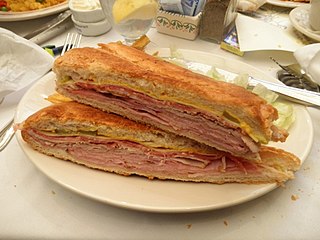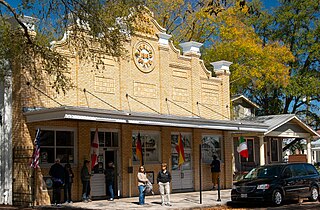
Tampa is a major city on the Gulf Coast of the U.S. state of Florida. The city's borders include the north shore of Tampa Bay and the east shore of Old Tampa Bay. Tampa is the largest city in the Tampa Bay area and the seat of Hillsborough County. With a population of 384,959 according to the 2020 census, Tampa is the third-most populated city in Florida after Jacksonville and Miami and is the 52nd most populated city in the United States.

A Cuban sandwich is a variation of a ham and cheese sandwich that likely originated in cafes catering to Cuban workers in Tampa or Key West, two early Cuban immigrant communities in Florida centered on the cigar industry. Later on, Cuban exiles and expatriates brought it to Miami, where it is also very popular. The sandwich is made with ham, (mojo) roasted pork, Swiss cheese, pickles, mustard, and sometimes salami on Cuban bread. Salami is included in Tampa, where there is a large Italian population, but is not usually included in South Florida.

Ybor City is a historic neighborhood just northeast of downtown Tampa, Florida, United States. It was founded in the 1880s by Vicente Martinez-Ybor and other cigar manufacturers and populated by thousands of immigrants, mainly from Cuba, Spain, and Italy. For the next 50 years, workers in Ybor City's cigar factories rolled hundreds of millions of cigars annually.

Braulio Alonso was a high school and junior high school teacher and principal. He served as the first Hispanic president of the National Education Association.

West Tampa is one of the oldest neighborhoods within the city limits of Tampa, Florida, United States. It was an independently incorporated city from 1895 until 1925, when it was annexed by Tampa.

Cuban bread is a fairly simple white bread, similar to French bread and Italian bread, but has a slightly different baking method and ingredient list ; it is usually made in long, baguette-like loaves. It is a staple of Cuban-American cuisine and is traditionally the bread of choice when making an authentic Cuban sandwich.
The modern history of Tampa, Florida, can be traced to the founding of Fort Brooke at the mouth of the Hillsborough River in today's downtown in 1824, soon after the United States had taken possession of Florida from Spain. The outpost brought a small population of civilians to the area, and the town of Tampa was first incorporated in 1855.

Ybor City Museum State Park is a Florida State Park in Tampa, Florida's Ybor City. The museum occupies the former Ferlita Bakery building at 1818 9th Avenue in the Ybor City Historic District. The bakery was known for producing cuban bread and its ovens are part of the museum displays covering the history of the cigar industry and the Latin community from the 1880s through the 1930s. There is also an ornamental garden in the building.

The Ybor City Historic District is a U.S. National Historic Landmark District located in Tampa, Florida. The district is bounded by 6th Avenue, 13th Street, 10th Avenue and 22nd Street, East Broadway between 13th and 22nd Streets. Ybor City contains a total of 956 historic buildings, including an unparalleled collection of architecture with Spanish-Cuban influence, as well as historic cigar factory buildings and associated infrastructure. The area was developed by businessman Vicente Martinez Ybor beginning in 1886, and was for a time the world's leading supplier of cigars.

The Centro Asturiano is a historic site in Ybor City, Tampa, Florida. It is located at 1913 Nebraska Avenue. On July 24, 1974, it was added to the U.S. National Register of Historic Places. It was designed by Tampa architect M. Leo Elliott.

The El Pasaje is a historic site in Ybor City, Tampa, Florida. It was originally built in 1886 to house the offices for Vicente Martinez Ybor's companies as he planned Ybor City and then ran his cigar factory and other businesses. El Pasaje has been home to many establishments since: a hotel, several restaurants, several bars and speakeasies, a military recruiting station, and newspaper offices, among others.

V.M. Ybor is a neighborhood within the city limits of Tampa, Florida, United States. As of the 2010 census, the neighborhood had a population of 1,743. The ZIP Codes serving the neighborhood are 33602, 33603, and 33605.

Vicente Martinez Ybor, was a Spanish entrepreneur who first became a noted industrialist and cigar manufacturer in Cuba, then Key West, and finally Tampa, Florida.

Ybor City is a historic neighborhood that includes the Ybor City Historic District in Tampa, Florida. It is located just northeast of downtown Tampa and north of Port Tampa Bay. The neighborhood has distinct architectural, culinary, cultural, and historical legacy that reflects its multi-ethnic composition. It was unique in the American South as a prosperous manufacturing community built and populated almost entirely by immigrants.

Nicholas Chillura Nuccio was a two-time mayor of Tampa, Florida in the 1950s and 60s. He was the Tampa's first mayor of "Latin" descent, having been born and raised in the immigrant neighborhood of Ybor City.

Tampa Bay History Center is a history museum in Tampa, Florida. Exhibits include coverage of the Tampa Bay area's first native inhabitants, Spanish conquistadors, and historical figures who shaped the area's history, as well as a reproduction of a 1920s cigar store. The museum is on the waterfront at 801 Old Water Street in Tampa's Channelside District. It opened on January 17, 2009. The History Center building is 60,000 square feet (5,600 m2) with 25,000 square feet (2,300 m2) of exhibit space.

The Tampa Smokers was a name used between 1919 and 1954 by a series of minor league baseball teams based in Tampa, Florida. The nickname was a nod to the local cigar industry, which was the most important industry in Tampa during the years in which the Smokers were active. During periods in which the name was not used by a professional team, various local semi-pro and amateur teams took up the Smokers name.

Gavino Gutierrez, a Spanish immigrant to the United States, was an importer, architect, civil engineer, and surveyor. He was responsible for bringing Vincente M. Ybor to Tampa, Florida and for designing Ybor City.

The Burgert Brothers were early photographers, most prominently known for documenting the growth of Tampa, Florida. Their photos span the late 1800s until the early 1960s. They depict times of war, natural disasters such as the 1921 Tampa Bay hurricane, economic booms, economic busts, transportation, building projects, bungalows, African American life, cigar factories, sponge docks, strawberry fields, mercantile businesses, banks, and service stations. They also feature Florida leisure activities at parks and beaches including golf, shuffleboard, checkers, and tennis. Thanks to the prolific Burgert Brothers local events and traditions like the Gasparilla Pirate Festival and Florida State Fair have been well-documented.

William Benton Henderson was a cattleman, merchant, and prominent figure in the history of Tampa, Florida. He is the namesake of Henderson Boulevard and Henderson Avenue as well as the former W. B. Henderson Elementary School.
















